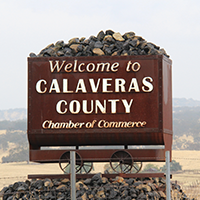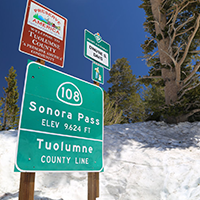
Valley residents seeking snowy fun in Big Trees State Park or ski adventures at Bear Valley Mountain will travel along Highway 4 through Calaveras County, which was ranked 14th nationally by a USDA study for scenic beauty and climate. Calaveras is full of historic Gold Rush towns, with period architecture and unique character along the rolling hills and giant valleys.
Angels CampWhile Angels Camp is best known for famous visitor Mark Twain and his story of the “Celebrated Jumping Frog of Calaveras,” there’s more than just frogs in this Gold Rush town.
For travelers looking to delve into Gold Rush history, there’s no better place to start than the Angels Camp Museum. The 3-acre historical park features one of the largest collections of carriages and wagons in the nation, two steam traction engines and exhibits highlighting mining equipment such as an overshot waterwheel in its original location, a hydraulic monitor, drills, ore carts and even a working model of a famous stamp mill.
The museum also features Mark Twain and Medicine in the Gold Rush exhibits.

“There’s a lot to see and do. It’s a great place to stop for families,” said Museum Director Kimberly Arth.
The museum offers a free scavenger hunt for children, with a prize at the end, and a gold panning experience.
Angels Camp is also home to Altaville School, one of the oldest and best preserved little red school houses in the state, and the Sam Choy Chinese Mercantile tells the story of the Chinese culture in the town.
For more information, visit
angelscamp.gov/museum/Copperopolis
The town of Copperopolis (originally called Copper Canyon) got its name from the copper lode discovered in 1860 that helped provide ammunitions for soldiers during the Civil War. Today the mines have all but disappeared, however, the 1800’s heritage of the foothill town has been reborn in the Copperopolis Town Square, a unique outdoor shopping and dining experience.
Designed around a traditional, pedestrian-friendly town square, the brick architecture and covered walkways harken back to another era, yet provide a modern retail setting. Travelers can get a bite to eat at Gold Dust Pizza or Griff’s Barbeque & Grill, stop by the Typsy Frog Wine Bar or grad a cup of joe at Roasters Coffee Corner. All things olive can be found at Copperopolis Olive Oil Company and Epic Worlds and Games offers something fun for all ages. The Town Square is also the perfect background for a family selfie or two. For more information and a complete list of eateries and shops, visit:
www.copperopolistownsquare.com/Copperopolis is also known to golfers worldwide as the home of Saddle Creek Golf Resort. The 18-hole championship course was designed by Carter Morrish and opened in 1996. This scenic and challenging course features both gentle and dramatic changes in elevation. Breathtaking views are just part of the experience, including dramatic views of the Sierras, Yosemite and a plentiful variety of wildlife. Since opening, the course has received numerous awards, including recognition as the 10th best public access course in the state of California by Golfweek Magazine in 2013. For more information, visit:
www.saddlecreekgolf.com/golf-course Off the beaten pathBy MARG JACKSON
A short drive east of Oakdale or south from Sonora, the tiny spot along Highway 108 known as Chinese Camp is often just a ‘pass through’ for travelers to the Stanislaus National Forest and Yosemite.
But spend a little time exploring and you will find some unique spots in the community for yourself.
The population sign at Chinese Camp says Population 150 – though that was a few years ago – and the elevation is 1,261, keeping it pretty much under the major snow level for the winter. The elevation has stayed the same but the number of residents has dropped by about half over the last several years.
“There was at one time about 8,500 people,” noted local Richard Moreci. “This was part of the Mother Lode gold vein.”
Gold was found in Chinese Camp and the rush of 1849 brought gold seekers, including those who hired Chinese to mine the area. Gold brought people, the railroad and a bustling community. The St. Francis Xavier Catholic Church, built in 1855, was restored in 1949 and is among the oldest buildings in the community. There are those who believe the historic structure to be haunted.
There’s a post office – Zip code 95309 – and residents who offer a friendly wave to passersby.

The influence of the Chinese can be seen in the Chinese Camp Science Academy, a building that looks like a Chinese temple but serves as a satellite school for the Jamestown Elementary School District. Science classes, with visiting scientists from Lawrence Livermore Labs, are hosted there for students a few days a week.
There’s an office of the Tuolumne County Visitors Bureau in Chinese Camp for maps, souvenirs and information and there’s a small store for essentials, getting supplies before heading further into the Mother Lode.
The location also proved to be perfect for Richard and Add Beale, who bought the Chinese Camp Store and Tavern earlier this year.
“We opened it July 1,” Beale said of taking over the store. “We had come up about a year earlier to collect fossils … we saw the store was for sale.”
It seemed to be too much of a coincidence.
“We wanted to raise the children on a farm or in a small family business,” he explained. “We sold everything we had.”
The couple purchased the store and made the move from their home in Tracy to live and work in Chinese Camp.

Richard, Add and their two children now call the community home.
“We get to work where we live,” Beale said. “We are the only store in a six-mile radius and we are a social center for every walk of life.”
Tourist trade is at its height during the summer, though Beale said he is looking forward to getting those people on their way to the snow this winter.
“It’s nice and peaceful, quiet,” noted Add. “Everyone around here is really friendly, I know everyone by name.”
Across the highway, the Tuolumne County Visitors Bureau office has maps, tourist information, a wide variety of Yosemite and Gold Country-themed souvenirs, books and clothing.
“We get quite a few coming and going from Yosemite National Park and visiting Tuolumne County,” said Lead Visitor Information Specialist Diane Rock. “People like to stop here and get that little gift.”
Travelers can also stay updated on road conditions, with a white board in the window of the office including information on what highways and passes are closed and what is open.
Chinese Camp is roughly 15 minutes south of Sonora, 35 minutes east of Oakdale.
Store owner Beale said while it’s not the bustling community it was when gold was first found and the influx of 49ers arrived, there’s still plenty of history and charm to soak up.
“We’re in it for the long haul,” Beale said.
Reviving StandardBy KRISTINA HACKERStandard, located four miles east of Sonora, was established as a company town for the Standard Lumber Company in 1902 and was a station on the Sierra Railway.
The lumber company changed hands over the years and was bought out by Sierra Pacific Industries in 1995.

Tony Benites purchased the township of Standard from Southern Pacific Industries Lumber Company in 1996. He has been restoring the older buildings and has added three new buildings trying to recreate the look and feel of the town when it was bustling in its heyday.
Eric Davis and his staff moved into the old Pickering Lumber Company office building which is now The Standard Pour in November 2010, bringing the historic town of Standard once again to life.
When traveling through the Sonora area, a trip to The Standard Pour for lunch or dinner and a craft beer will offer great views and a little history.





